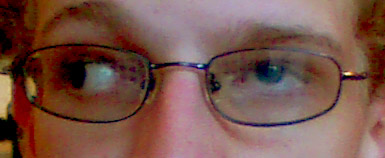Duane syndrome
| Duane syndrome | |
 | |
|---|---|
| An individual diagnosed with Duane syndrome in the left eye. In this image, the affected person is attempting to look far right. Notice the afflicted left eye faces straight and up (an "upshoot"), rather than following the right eye to the right. | |
| ICD-10 | H50.8 |
| ICD-9 | 378.71 |
| OMIM | 126800 604356 |
| DiseasesDB | 30810 |
| eMedicine | oph/326 |
| MeSH | D004370 |
Please Take Over This Page and Apply to be Editor-In-Chief for this topic: There can be one or more than one Editor-In-Chief. You may also apply to be an Associate Editor-In-Chief of one of the subtopics below. Please mail us [1] to indicate your interest in serving either as an Editor-In-Chief of the entire topic or as an Associate Editor-In-Chief for a subtopic. Please be sure to attach your CV and or biographical sketch.
Overview
Duane syndrome (DS) is a rare, congenital eye movement disorder most commonly characterized by the inability of the eye to turn out. The syndrome was named for Alexander Duane who identified it in 1905.[1][2]
Other names for this condition include: Duane's Retraction Syndrome (or DR syndrome), Eye Retraction Syndrome, Retraction Syndrome, Congenital retraction syndrome and Stilling-Turk-Duane Syndrome.[3]
Causes
DS is a miswiring of the eye muscles, causing some eye muscles to contract when they shouldn't and other eye muscles not to contract when they should.[3] People with DS have a limited (and sometimes absent) ability to move the eye outward toward the ear (abduction) and, in most cases, a limited ability to move the eye inward toward the nose (adduction).
Presentation
Often, when the eye moves toward the nose, the eyeball also pulls into the socket (retraction), the eye opening narrows and, in some cases, the eye will move upward or downward. Many patients with DS develop a face turn to maintain binocular vision and compensate for improper turning of the eyes. When attempting to view an object outside of his or her binocular viewing range (which may be very narrow), the patient may experience double vision as the eyes face different directions. As a result, the individual may come to rely predominantly on the unaffected eye for visual data, and additionally may resort to turning the entire head to perform tasks such as reading, rather than moving the eyes.
In about 80 per cent of cases, only one eye is affected, most often the left. However, in some cases, both eyes are affected, with one eye usually more affected than the other.
Up- and downshooting may be present in side gaze. This most commonly is due to the "leash" effect of a tight horizontal rectus muscle (usually the lateral rectus).
Epidemiology
Most patients are diagnosed by the age of 10 years and DS is more common in girls (60 percent of the cases) than boys (40 percent of the cases). Around 10-20% of cases are familial; these are more likely to be bilateral than non-familial Duane syndrome. Duane syndrome has no particular race predilection. While usually isolated to the eye abnormalities, Duane syndrome can be associated with extraocular problems (so-called "Duane's Plus"), including cervical spine abnormalities (Klippel-Feil syndrome), Goldenhar syndrome, autism, heterochromia,and thalidomide-induced embryopathy.
Treatment
Duane syndrome cannot be cured, as the "missing" cranial nerve cannot be replaced. Treatment, therefore, is properly directed toward: correcting refractive errors, normalizing head position, expanding field of binocularity, and minimizing up- and downshoots. Strabismus surgery is often helpful; occasionally this is not needed during childhood, but becomes appropriate later in life, as the head position changes (presumably due to progressive muscle contracture).
Prominent down- or upshoots (such as that pictured above) may be treated with a special form of muscle surgery, a "Y-splitting" procedure, often combined with a recession.
Vertical Rectus Transposition sugery has achieved increased lateral motility in many cases. The VRT realigned muscles work with the good medial muscle to provide a "tripod" of musculature for the eye; the newly moved muscles provide torque and tension against the medial muscle, which is what allows for the central alignment. And, because they are "working" muscles, they also may allow for some range of movement (lateral) in their new position. Dr. Arthur Rosenbaum at UCLA is a leading practitioner of this technique.
References
- ↑ Template:WhoNamedIt
- ↑ A. Duane. Congenital deficiency of abduction, associated with impairment of adduction, retraction movements, contraction of palpebral fissure and oblique movements of the eye. Archives of Ophthalmology, Chicago, 1905, 34: 133-159.
- ↑ 3.0 3.1 "genome.gov". Retrieved 2007-06-06. Text " Learning About Duane Syndrome " ignored (help)